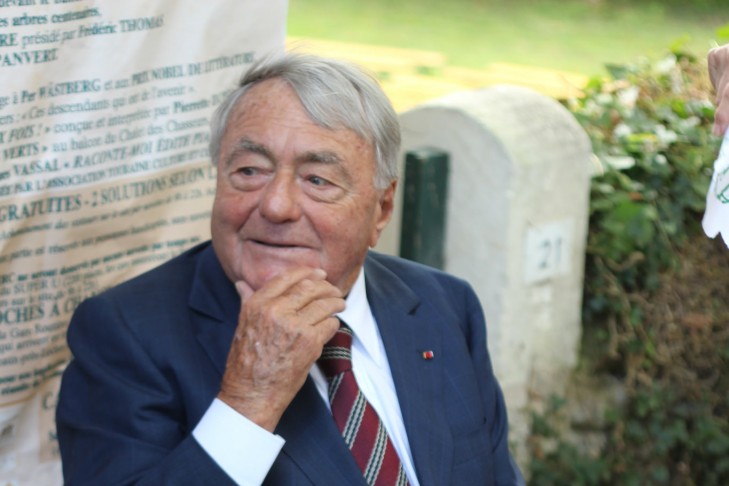Filmmaker and writer Claude Lanzmann died earlier this month in Paris at the age of 92. Lanzmann is best known for his 1985 cinematic masterpiece “Shoah,” which clocked in at just over nine hours. The film took 12 years to complete and brought Lanzmann to Israel, the United States, Poland and Germany, where he pursued survivors and perpetrators alike. A recent tribute to Lanzmann in The New Yorker called the film “the crucial cinematic confrontation with the Holocaust.”
Born in Paris, Lanzmann was the son of assimilated French Jews. As a teenager, he joined the French Resistance, risking his life as he smuggled small arms. After the war, Lanzmann was a well-known intellectual and worked with Jean-Paul Sartre at his magazine, along with Simone de Beauvoir, with whom he had a nine-year affair.
Though none of his family members perished in the concentration camps, Lanzmann has said in interviews that once he began making “Shoah,” he could not stop. Israel’s Ministry of Foreign Affairs originally commissioned Lanzmann to make a standard-length film about the Holocaust from a Jewish point of view. That was 1973, and four years into the project the ministry cut off further funding. Nevertheless, Lanzmann persisted. He told The New York Times before the re-release of the film: “I was like a blind man during the 12 years of the making of ‘Shoah,’ like a horse with blinders. I could not look right or left, only straight ahead into the black circle of the shoah.”
The intensity and artistry of “Shoah” reflect Lanzmann’s unflinching gaze as a director and Jew who was deeply affected by the Holocaust. As he writes in his memoir, “The Patagonian Hare,” translated into English in 2012, there is no archival footage or images in “Shoah.” Everything is in the present tense. “I knew from the start that I would not use archive images,” he writes. “The most powerful and most luminous reason for this refusal did not occur to me immediately; it became obvious only when I understood the nature of the film I had been called to make.”
In his memoir, Lanzmann further points out that there are also no individual stories featured in the film. He writes, “that the living would be self-effacing so that the dead might speak through them, that there would be no ‘I’, however fantastical or fascinating or atypical an individual fate might be; that on the contrary the film would take on a strict form…recounting the fate of the people as a whole, and that those who spoke for them, forgetting themselves and supremely conscious of their duties to pass on their memories….”
Lanzmann was also a purist when it came to language. He intensely disliked the word Holocaust, which he said actually referred to a burnt offering to a god. In the same New York Times interview, Lanzmann bluntly asserted: “To reach God 1.5 million Jewish children have been offered? The name is important, and one doesn’t say ‘Holocaust’ in Europe. This was a catastrophe, a disaster, and in Hebrew that is shoah.” Lanzmann never learned Hebrew, but he was devoted to Israel, beginning with his first visit to the Jewish state in 1952.
Lanzmann’s purist streak also extended to works that fictionalized or repurposed the Holocaust. He was critical of Roberto Benigni’s “Life Is Beautiful” and Steven Spielberg’s “Schindler’s List.” He was a fan of the work of Italian writer and Holocaust survivor Primo Levi, who quoted a concentration camp guard in his own memoir, “Survival in Auschwitz,” saying, “Here there is no why.” Like Lanzmann, Levi’s style was simple, straightforward and devastating.
One of the most famous scenes in “Shoah” is the interview Lanzmann conducted with Abraham Bomba, referred to as the “Barber of Treblinka.” Finding Bomba was an arduous task, particularly pre-internet. Acting on a tip, Lanzmann looked him up in New York City phonebooks and knocked on countless doors in the Bronx looking for anyone who might have known Bomba. He went to 15 barbershops until he found Bomba living in the Pelham section of the Bronx. The two men spent a day together in Tarrytown, where Lanzmann pre-interviewed Bomba for the film. But Lanzmann lost track of his subject and by luck found him a few years later in a barbershop in Tel Aviv cutting hair.
As he casually goes about giving a customer a trim, Bomba says that at Treblinka, he was a Sonderkommando. His job was to usher naked women into the gas chamber, where he cut their hair just before they were murdered. Sometimes he recognized these women from his hometown. The interview is almost unbearable to watch, and Lanzmann writes in his memoir that after it was over, and the camera was off, he and Bomba embraced.
The fact that “Shoah” exists in a world in which two-thirds of American millennials don’t know what Auschwitz is and 22 percent of them said they were unsure or did not know what the Holocaust was makes the film all the more relevant. As the director of the Israel Ministry of Foreign Affairs noted when the making of “Shoah” began: “It’s not a matter of making a film about the shoah, but a film that is the shoah.”



